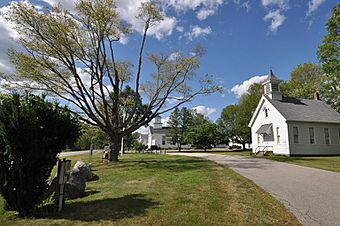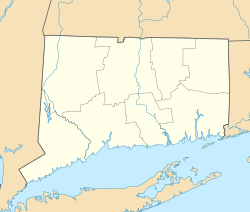Salem Historic District (Salem, Connecticut) facts for kids
Quick facts for kids |
|
|
Salem Historic District
|
|
 |
|
| Location | CT 85, Salem, Connecticut |
|---|---|
| Area | 76 acres (31 ha) |
| Built | 1831 |
| Architectural style | Greek Revival, Gothic Revival |
| NRHP reference No. | 80004063 |
| Added to NRHP | September 22, 1980 |
The Salem Historic District is a special area in Salem, Connecticut. It shows what the town center looked like in the 1800s. This district runs along Connecticut Route 85 and includes many old buildings. You can see important town buildings and homes here. The area started growing after Salem became a town in 1819. Most of these buildings were finished by 1885. This historic district was added to the National Register of Historic Places in 1980.
Contents
Discovering Salem's Past
Salem was a farming area in the early 1800s. It became its own town in 1819. At that time, about 1,000 people lived there. Before 1819, Salem didn't have a main town center. People used services in nearby towns. The town center slowly grew along the main road, now called CT 85.
How Salem's Center Developed
The heart of Salem's historic area is around a small town green. Here you will find several important buildings.
Buildings Around the Green
- The Congregational Church was built around 1840. It has a style called Greek Revival.
- The Queen Anne Grange Hall was built in 1885. It started as a school before becoming the Grange Hall.
- The Old Town House is one of the oldest buildings. It was built in 1749 in Norwich, Connecticut. It was moved to Salem in 1831. An old church group added its Gothic Revival style features. Later, the town bought the building. It is now home to the local historical society.
Other Important Places in Salem
- The town library was built around 1929. A famous person from Salem helped fund it. His name was Hiram Bingham III. He was an explorer and a politician.
- You can also find parts of the Music Vale Seminary. This was a music school that opened in 1835. It closed in 1876. The main school building burned down in 1897. But a barn and other parts of its grounds are still there. They are near the southern end of the district.
- "The Tavern" is also in this area. It might be the oldest building built right in the district. It was built around 1720. This was the home of Reverend John Whittlesey. His house was a common stop for travelers. They would stop here on their way between Hartford and New London.



